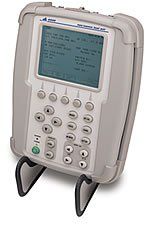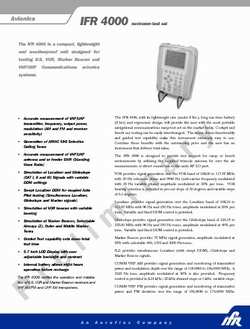IFR 4000 Improves on All Fronts
Aeroflex's wholly owned subsidiary IFR has announced the IFR
4000, a new navigation communications (NAV-COMM) ramp test set;
it's based on a completely new architecture and ergonomic design
that, the company says, "is the platform for future IFR ramp test
sets."
 Replacing the venerable NAV-402AP navigation communications
ramp test set, the IFR 4000 (right) is a self-contained, handheld
unit designed for ramp testing, but is equally at home in bench
test applications. It performs functional testing, signal
generation and calibration of Marker Beacon (MKR), VHF
Omnidirectional Radio Range (VOR), Instrument Landing System (ILS)
and VHF/UHF Communications (COMM) avionics systems.
Replacing the venerable NAV-402AP navigation communications
ramp test set, the IFR 4000 (right) is a self-contained, handheld
unit designed for ramp testing, but is equally at home in bench
test applications. It performs functional testing, signal
generation and calibration of Marker Beacon (MKR), VHF
Omnidirectional Radio Range (VOR), Instrument Landing System (ILS)
and VHF/UHF Communications (COMM) avionics systems.
The IFR 4000 is priced at U.S. $11,500 -- $1,700 less than the
NAV-402AP. The instrument offers a new Guided Test function
allowing the operator to create custom test sequences, reducing
total test time.
"There is no other navigation communications test set on the
market today that delivers such an outstanding combination of
price, portability and ease of use," said Jeff Gillum, director,
wireless products, IFR. "The IFR 4000 is designed for easy
operation, reliability, long service life and its size is
especially convenient for the confined space of cockpit testing.
Weighing just eight pounds, less than half the weight of the
NAV-402AP, with a battery life of eight hours, the IFR 4000 is
certain to replace the NAV-402AP as the new industry standard."
Features:
 The IFR 4000 allows accurate measurement of
VHF/UHF transmitter frequency, output power, modulation (AM and FM)
and receiver sensitivity, VHF/UHF antenna and/or feeder Standing
Wave Ratio (SWR). It can simulate Localizer and Glideslope (CAT I,
II and III) signals with variable Difference in Depth of Modulation
(DDM) settings. The instrument has a Swept Localizer DDM for
coupled AutoPilot testing including simultaneous Localizer,
Glideslope and Marker Beacon signals, as well as simulation of VOR
beacon with variable bearing. It can also generate ARINC
(Aeronautical Radio, Inc.) 596 Mark 2 airborne Selective Calling
tones (SELCAL), allowing a ground radio operator to alert an air
crew that the operator wishes to communicate with that
aircraft.
The IFR 4000 allows accurate measurement of
VHF/UHF transmitter frequency, output power, modulation (AM and FM)
and receiver sensitivity, VHF/UHF antenna and/or feeder Standing
Wave Ratio (SWR). It can simulate Localizer and Glideslope (CAT I,
II and III) signals with variable Difference in Depth of Modulation
(DDM) settings. The instrument has a Swept Localizer DDM for
coupled AutoPilot testing including simultaneous Localizer,
Glideslope and Marker Beacon signals, as well as simulation of VOR
beacon with variable bearing. It can also generate ARINC
(Aeronautical Radio, Inc.) 596 Mark 2 airborne Selective Calling
tones (SELCAL), allowing a ground radio operator to alert an air
crew that the operator wishes to communicate with that
aircraft.
The IFR 4000 incorporates a large 5.7-inch LCD display with
user-adjustable backlight and contrast. It has an internal battery
for eight hours of continuous operation before recharging.
Automatic power shutdown occurs after five to 20 minutes
(selectable) of non-use when the AC power is not connected.
The IFR 4000 verifies the proper operation and installation of
ILS, VOR and Marker Beacon receivers and VHF AM/FM and UHF AM
transceivers by using eight dedicated operational modes. To
accurately test the ILS system, the IFR 4000 breaks down the
testing requirement into three modes of operation: Localizer,
Glideslope and Marker Beacon. The IFR 4000 provides signal
generation of 108.10 to 111.95 MHz for Localizer and 329.15 to
335.00 MHz for Glideslope along with the necessary 90 and 150 Hz
modulation control to simulate out-of-course indications. For
Marker Beacon the IFR 4000 provides the 75 MHz MB signal with
selectable 400, 1300 and 3000 Hz tones. The IFR 4000 also provides
simultaneous Localizer with swept DDM, Glideslope and Marker Beacon
signals for testing of the AutoPilot function.
 ANN's Daily Aero-Linx (05.02.24)
ANN's Daily Aero-Linx (05.02.24) ANN's Daily Aero-Term (05.02.24): Touchdown Zone Lighting
ANN's Daily Aero-Term (05.02.24): Touchdown Zone Lighting Aero-News: Quote of the Day (05.02.24)
Aero-News: Quote of the Day (05.02.24) ANN FAQ: Contributing To Aero-TV
ANN FAQ: Contributing To Aero-TV NTSB Final Report: Cirrus Design Corp SR20
NTSB Final Report: Cirrus Design Corp SR20




